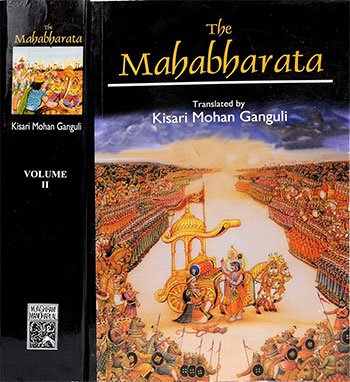Section LXXI [summary]
Book index: Mahabharata (English)
This page contains a summary of the Mahabharata Section LXXI including examples of moral lessons in daily life. The Maha-Bharata is one of the largest epics ever written containing roughly 100,000 Sanskrit verses. It deals with the legendary history of ancient India and contains a large number of interwoven tales.
Short summary of the chapter:
In this passage from the Vana Parva of the Mahabharata, Vrihadasva narrates the story of Nala, who is disguised as Vahuka at the command of king Rituparna. Nala's heart is heavy with grief as he ponders the reasons behind Damayanti's decision to hold a Swayamvara, possibly to test his loyalty. Despite his inner turmoil, Nala resolves to go to the Swayamvara to ascertain the truth. He carefully selects lean yet strong horses for the journey, much to Rituparna's initial skepticism. However, Nala's expertise in horsemanship is revealed as he successfully yokes the steeds and rapidly sets out towards the Vidarbha kingdom.
Nala's skill in guiding the horses astonishes both Rituparna and his charioteer Varshneya, who suspect that Vahuka may actually be Nala in disguise. Varshneya, having served Nala in the past, notices similarities in their knowledge and abilities. Despite Vahuka's unassuming appearance, Varshneya believes that Nala's true identity may be hidden due to unfortunate circumstances or divine ordinance. Rituparna is also impressed by Vahuka's equestrian skills and marvels at his dedication and proficiency in handling the horses.
As Vahuka and his entourage journey towards the Vidarbha kingdom, the miraculous speed and control of the horses continue to astound Rituparna and Varshneya. Varshneya contemplates the possibility that Vahuka is indeed Nala, possibly stripped of his regal appearance as a result of his past misfortunes. Rituparna, on the other hand, is thoroughly pleased with Vahuka's competence and is grateful for the swift progress towards their destination.
The passage highlights Nala's unwavering determination to confront Damayanti and reveals his exceptional skills in horsemanship through Vahuka. The doubts surrounding Vahuka's true identity add an element of mystery and intrigue to the narrative, captivating both the characters and the readers. Nala's journey to the Swayamvara promises to bring about significant revelations and possibly a resolution to the tangled web of emotions and relationships at play.
Full English translation:
This page is merely a summary which is automatically generated. If you are looking for authentic sources such as the Sanskrit text or the Full English translation of Mahabharata Section LXXI, have a look at the following articles:
Section LXXI, online text
English translation by Kisari Mohan Ganguli.
Read this and other chapters online.
Mahabharata (English Summary)
by Kisari Mohan Ganguli | ISBN-10: 8121505933
Buy the latest edition:
FAQ of Section LXXI:
Who was Vahuka and why did he go to Damayanti's Swayamvara?
Vahuka was actually the skilled Nala in disguise. He went to verify Damayanti's intentions and potentially win her back.
What horses did Vahuka choose for the journey to Vidarbha?
Vahuka chose lean, strong, and energetic horses from Sindhu, with specific markings. They were capable of a long journey.
How did Varshneya, the charioteer, react to Vahuka's skills?
Varshneya was amazed by Vahuka's horse-handling abilities and began to suspect his true identity as Nala.
Mahabharata Section LXXI in daily life:
In the story of Nala and Rituparna, we learn about resilience, the power of skill mastery, and the importance of facing challenges with determination and wisdom. The tale illustrates how Nala, despite his personal sorrow and the disguise he wore, chose to support King Rituparna's desires while also seizing the opportunity to pursue his own goals. This teaches us the importance of pushing through difficult situations with hope and skill, even when the future seems uncertain.
Nala's expertise in handling horses, despite being questioned by Rituparna, showcases the value of trusting one's abilities and knowledge. It serves as a reminder that even when others doubt us, staying true to our expertise can lead to surprising outcomes. This can be applied in daily life by believing in our unique skills and consistently working to improve them, knowing that they will eventually lead to our desired goals.
Moreover, the story emphasizes the significance of not losing sight of personal objectives, even when assisting others with theirs. Nala uses his assignment from Rituparna as a means to progress towards his own reunion with Damayanti. This teaches us the importance of looking for opportunities within our responsibilities that align with our personal growth and goals, demonstrating how every challenge can also be an opportunity if approached with the right mindset.
